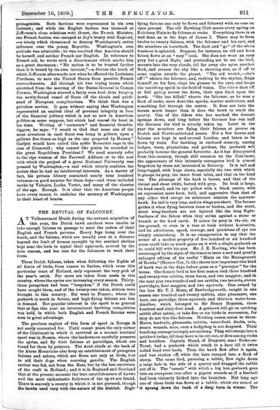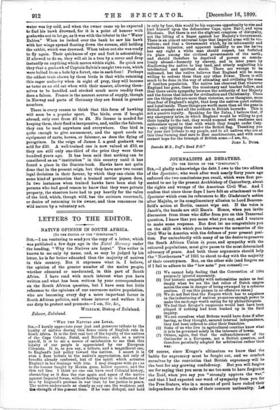THE REVIVAL OF FALCONRY.
AT Valkensvaard Heath during the autumn migration of this year, the Dutch hawk catchers were unable to take enough falcons on passage to meet the orders of their English and French patrons. Heavy fogs hung over the heath, and the falcons, which are usually seen at a distance beyond the limit of human eyesight by the sentinel shrikes kept near the huts to signal their approach, arrived by the nets unseen, and too late for the falconera to work their lures.
These Dutch falcons, taken when following the flights of all kinds of birds, from cranes to finches, which cross this particular tract of Holland, only represent the very pick of the year's catch. Far more are taken from nests in this country, where the eyries are increasing every season. Thirty- three peregrines had been " bespoken," if the Dutch could have caught them, and of the twenty-two taken, sixteen were brought to this country. Six went to France ; where the goshawk is much in favour, and high-flying falcons are less in demand. But popular interest in the sport is so general that at Spa this year an international hawking competition was held, in which both English and French falcons were seen to great advantage.
The previous neglect of this form of sport in Europe is not easily accounted for. Until recent years the only corner of the Continent in which it survived as a normal national sport was in Bosnia, where the landowners carefully preserve the eyries, and fly their falcons at partridges, which are found for them by pointers. The Arab chiefs at the back of the Aures Mountains also keep an establishment of peregrine falcons and rakers, which are flown not only at birds, b ut to aid their dogs when coursing gazelle. The English revival was fed, not from the East, but by the last survivors of the craft in Holland ; and it is in England and Scotland that at the present moment the best establishments of hawks and the most enthusiastic followers of the sport are found. There is scarcely a county in which it is not pursued, though the hawks used vary with the nature of the district. High- flying falcons can only be flown and followed with suecess on open ground. The old Hawking Club meets every spring on Stliabary Plain to fly falcons at rooks. Everything there is as well done as in the days of James I. There may be from twelve to twenty falcons, with the falconer and his cart, and the members on horseback. The dash and "go" of the whole business is splendid. Suppose, for instance, an old and keen falcon flown at an "easy" rook. She does not want an easy prey but a good flight, and pretending not to see the bird, mounts into the very clouds, till far away she spies another flock, and crosses the sky like a shooting star, as if off to some region outside the planet. "The old wretch,—she's off ! " shouts the falconer, and, rushing to the skyline, flings himself on his face, claps his glasses to his eyes, and keeps the vanishing speck in the field of vision. The riders dash off at full gallop across the down, their eyes fixed upon the hawk. "She has killed," shouts the falconer, as he sees a flock of rooks, mere dust-like specks, scatter mtiltivions, and something fall through the centre. It does not take the horses much longer than it does the hawk to reach the quarry. One of the riders who has marked the descent springs down, and long before the falconer has run half the distance the bird is already taken up. Later in the year the members are flying their falcons at grouse on Scotch and Northumberland moors. Not a few hawks and falcons are kept in and around London, and taken to be flown by train. For hawking in enclosed country, among hedges, trees, plantations, and gardens, the goshawk will probably become the general favourite. As it has disappeared from this country, though still common on the Continent, the appearance of this intensely courageous bird is almost forgotten by those not interested in falconry. It is tall and long-legged, with huge claws, especially the two with which it grasps its prey, the inner front talon, and that on the hind toe. The plumage of the back is brown, and that of the throat and chest white, barred with grey. Its beak is large, its head small, and its eye yellow with a black centre, with an expression more keen, bold, and aggressive than that of any other bird except its miniature relation the sparrow- hawk. Its tail is very long, and its wings are short. The former guides it when flying between trees or bushes, and the stout, short wing-feathers are not injured like the long flight- feathers of the falcon when they strike against a stone or branch or the hard earth. It seizes its prey in the air, on the ground, or even in a tree or bush without hesitation, and its adroitness, speed, courage, and quickness of eye are simply astonishing. It is no exaggeration to say that the owner of a modest property of five hundred or six hundred acres could take as much game on it with a single goshawk as he could kill with his gun. Mr. J. E. Harting, who has been encouraged by the signs of the times to issue a new and greatly enlarged edition of his useful " Hints on the Management of Hawks," (Horace Cox, 7s.6d.) shows how important this kind of hawk was in the days before guns as a " purveyor " for the house. One female bird in her first season took three hundred and twenty-two rabbits, three hares, and two magpies; and in the next year two hundred and ten rabbits, two leverets, eleven partridges, four magpies, and two squirrels. One owned by the late Mr. T. J. Mann, of Sawbridgewortb, caught in one season one hundred and twenty rabbits, nine pheasants, one hare, one partridge, three squirrels, and thirteen water-hens. Another, which belonged to Sir Henry Boynton, three hundred and sixty-four head. A goshawk will go on catching rabbit after rabbit, or take five or six birds in succession, for they do not tire like falcons. Nothing comes amiss to them- Hares, landrails, pheasants, rabbits, water-fowl, ducks, rats, stoats, weasels, mice, even a hedgehog is not despised. Their headlong courage ia si mply astonishing. They will charge into a quickset hedge, till they have to be cut out, or dive among rocks and boulders. Captain Bland, of Draycott, near Stoke-on- Trent, had a goshawk which stuck to a hare till it twice rolled head over heels. Then the hawk flew after it again, and was shaken off, while the hare escaped into a flock of sheep. The same bird, pursuing a rabbit, flew right down a large hole in the side of a quarry and dragged the rabbit out of it. The "smash" with which a big hen goshawk goes into an evergreen. tree after a pigeon sounds as if a football had been violently kicked into the branches. Not long ago one of these birds was flown at a rabbit, which she seized as it sprang down the bank of a deep burn in winter. The water was icy cold, and when the owner came up be expected to find his hawk drowned, for it is a point of honour with goshawks not to let go, as it was with the lobster in the "Water Babies." • When he looked over the bank he saw his hawk with her wings spread floating down the stream, still holding the rabbit, which was drowned. When taken out she was ready to fly again. Their quickness of eye and foot is astonishing. If allowed to do so, they will sit in a tree by a cover and drop instantly on anything which moves within sight. So quick are they that a goshawk of Captain Salvin's caught two rate, which were boiled from a hole by a ferret, one in each foot! Perhaps the oddest trait shown by these birds is that while retaining this eager audacity when in sight of prey, they will become as tame as an old cat when with their master, allowing them- selves to be handled and stroked much more readily than does a falcon. France is the nearest source of supply, though in Norway and parts of Germany they are found in greater numbers.
There is every reason to think that this form of hawking will soon be a popular sport. The birds, even if bought abroad, only cost from £3 to £4. No license is needed for keeping them, their food is inexpensive, and, unlike the falcons, they can be used anywhere and everywhere. One bird is quite enough to give amusement, and the sport needs no equipment of carts, horses, or falconer, as does the flying of peregrines. In the reign of James L a good goshawk was sold for £30. A well-trained one is now valued at £10, so they are still only one-third of the price they were three hundred years ago. It has been said that nothing can be considered as an " institution " in this country until it has found a place in the Statute-book. Hawks have not quite done that in the present reign, but they have now two recent legal decisions in their favour, by which they can claim the same kind of protection that a trained carrier pigeon does, In two instances when trained hawks have been shot by persons who had good reason to know that they were private property, the shooters have had to pay heavily for the value of the bird, which, though wild, has the animum revertendi, or desire of returning to its owner, and thus renounces its wild nature by a voluntary act.











































 Previous page
Previous page